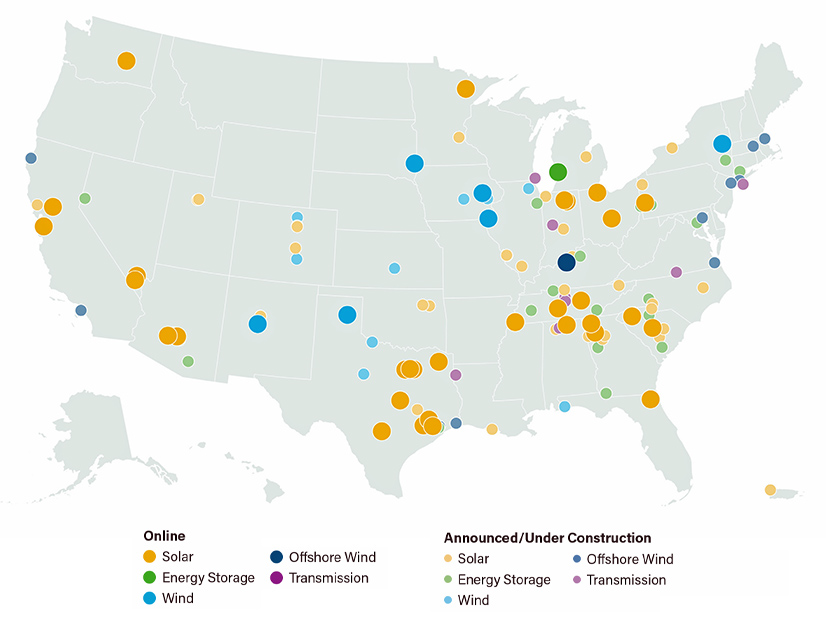The American Clean Power Association reports that U.S. clean energy investments announced over the past two years have reached a half-trillion dollars.
That money would pay for at least 161 new manufacturing facilities, with the potential for more than 100,000 new manufacturing jobs and more than 300 GW of new emissions-free power generation.
Most of the spending and much of the resulting infrastructure are in the future, but the commitments are significant enough for ACP to declare it a manufacturing renaissance in “Clean Energy Investing in America,” the report it issued Aug. 7.
“These historic investments are providing a powerful engine for job creation across the nation,” ACP CEO Jason Grumet said in a news release. “As demand for electricity continues to rise, clean power is answering the call and propelling a new era for American manufacturing.”
The two-year period in the report overlaps a historic infusion of federal funding intended to encourage exactly what the report quantifies: clean energy development and the creation of a domestic manufacturing base to supply it.
The Inflation Reduction Act, signed into law by President Biden in August 2022, has provided billions to encourage the changes the ACP report highlights.
In the latest example, a day after the report was released, the Department of Energy’s Loan Programs Office announced a $1.45 billion conditional loan guarantee for Qcells to set up what is expected to be the largest solar ingot and wafer factory ever built in the United States.
The LPO said the Georgia facility would be the first vertically integrated U.S. solar factory in more than a decade and would re-establish critical parts of the domestic supply chain for photovoltaics.
Grumet said that while headline numbers in the ACP report are remarkable, they are only part of the clean energy transition: “Our ability to deploy new capacity with adequate speed and scale requires dramatic efficiency improvements in federal, state and local decision making. ACP is encouraged by recent bipartisan progress to confront barriers to modernizing America’s energy economy.”
The report’s statistics run through June 30, 2024. At that point, most of the benefits cited in the report were yet to come:
-
- $500 billion in investments had been announced, but only $75 billion had been made.
-
- Construction or expansion of at least 161 manufacturing facilities had been announced, but at least 119 of the projects were in development.
-
- Only 20,000 of the anticipated 100,000 new manufacturing jobs had been created.
-
- Only about 55 GW of the announced 300 GW of new clean energy generating capacity had become operational.
Breaking down the numbers:
-
- Solar leads the way in new generation, with 33 GW of new capacity built, at a cost of $42 billion. Onshore wind (11.6 GW, $20 billion) and storage (10 GW, $12 billion) are a distant second and third.
-
- New generation projects totaling $363 billion account for the bulk of the announced $500 billion of investment, followed by manufacturing ($61 billion), supply agreements ($47 billion) and other sectors ($28 billion).
ACP’s report intersperses the project lists and dollar counts with vignettes diving deeper into some of the new manufacturing created in the past two years:
-
- Form Energy built the first factory for its iron-air, 100-hour battery system in Weirton, W.Va., on the site of a demolished steel mill that was the economic and cultural heart of that community for generations.
-
- GE Vernova announced a $50 million expansion and 200 new jobs at its Schenectady, N.Y., facility, where it produces the largest land-based wind turbine in the United States.
-
- Illuminate USA announced, built and opened a massive plant in Pataskala, Ohio, to produce advanced solar panels. Its workforce already exceeds 800 “illuminators,” and the company expects to surpass 1,200 by the end of 2024.
-
- Vestas, which already invested more than $1 billion in Colorado factories that produce wind turbine blades and nacelles, announced a $40 million expansion of the two facilities and plans to hire upward of 1,000 people.
Grumet said much more is possible — the nation can be a global leader in clean energy: “If we combine innovations in technology and governing, it is possible to achieve an energy system that is reliable, affordable, secure and clean.”
